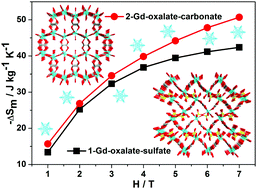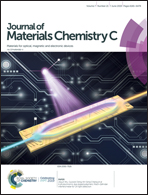A large magnetocaloric effect in two hybrid Gd-complexes: the synergy of inorganic and organic ligands towards excellent cryo-magnetic coolants†
Abstract
Cryo-magnetic coolants based on the magnetocaloric effect (MCE) usually need relatively large fields to achieve practical cooling performance. Thus, it is important to hunt for molecular cryo-magnetic coolants with superior performance of the MCE under low fields (smaller than 2 T), considering the readily attainable low fields from commercialized Nd–Fe–B permanent magnets. In this work, the crystal structure, magnetic susceptibility and isothermal magnetization for two hybrid Gd-complexes, (NH4)[Gd(C2O4)(SO4)(H2O)] (1) and [Gd(C2O4)0.5(CO3)(H2O)] (2), cobridged by organic and inorganic ligands, were solvothermally synthesized and magnetically characterised, with the goal of obtaining novel molecular cryo-magnetic coolants. For 1, the sulfate bridges GdIII ions to generate inorganic chains as supramolecular building blocks (SBBs), which are further connected by the oxalate to result in the final host anionic architecture with an ammonium ion as the guest to balance the charge. For 2, the carbonate bridges GdIII ions to form inorganic layers as SBBs, which are further linked by the oxalate to give birth to the resultant pillar-layer structure. Because the merits of organic oxalate ligands and inorganic ligands (sulfate and carbonate) work together, the resultant compounds show a weak magnetic exchange interaction, a low molecular weight and a dense frame structure, and the observed maximum entropy change (−ΔSmaxm) is up to 42.4 J kg−1 K−1 for 1 at ΔH = 7 T and T = 2 K and 50.7 J kg−1 K−1 for 2 at ΔH = 7 T and T = 4 K, beyond the performance of commercialized gadolinium gallium garnet Gd3Ga5O12 (GGG, −ΔSmaxm = 38.4 J kg−1 K−1 with ΔH = 7 T). Notably, the −ΔSmaxm still reaches 25.2 J kg−1 K−1 for 1 and 26.8 J kg−1 K−1 for 2 at T = 2 K and ΔH = 2 T, and 32.3 J kg−1 K−1 for 1 and 33.3 J kg−1 K−1 for 2 at T = 2 K and ΔH = 3 T, which already outperform GGG (about 24 J kg−1 K−1 with ΔH = 3 T) and make them excellent cryo-magnetic refrigerants for low-temperature applications, even under low external fields.



 Please wait while we load your content...
Please wait while we load your content...